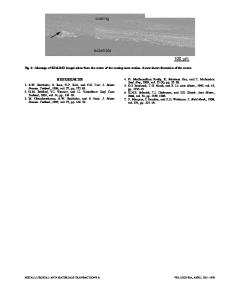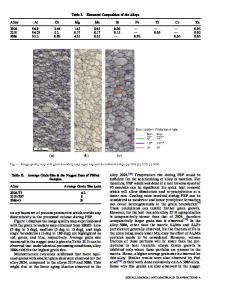Microstructural Evolution During Friction Surfacing of Dissimilar Aluminum Alloys
- PDF / 1,235,968 Bytes
- 8 Pages / 593.972 x 792 pts Page_size
- 34 Downloads / 383 Views
INTRODUCTION
FRICTION surfacing (FS) is a friction-based process capable of depositing consumable materials on the substrate surface, as illustrated in Figure 1. It was first mentioned as a known metal-coating process in a patent by Klopstock and Neelands in 1941.[1] During FS, initially, the consumable material is rotated under pressure such that it rubs the substrate surface, producing high-speed friction on the contacting surface between the rod end and the substrate surface. Frictional heat is generated quickly, resulting in local plastification of the consumable at the contacting surface. As the temperature increases, the torque decreases, and the process reaches a steady state, resulting in the formation of a material layer between the consumable and the substrate. Subsequently, the consumable travels along the surface to be coated. Then, the material layer is transferred slice by slice to form a coating layer on an area of interest. The localized heat at the contacting surface promotes a significant temperature gradient, leading to adhesion of the interlayer on the substrate surface.[2] Further details on the FS process can be found in previous studies.[1–8] During the process, the material experiences severe plastic deformation and thermal exposure. This may lead to the formation of a fine-grained structure. Because the microstructure developed during FS strongly affects the properties of the deposited layer, understanding how the microstructure develops during the process becomes important. Bonding integrity and deposited-material properties are significant issues in FS. Accordingly, some investigations have been conducted to clarify the bonding U. SUHUDDIN, Postdoctoral Fellow, H. KROHN, Ph.D. Student, M. BEYER, Scientist, and J.F. DOS SANTOS, Department Head, are with the Solid State Joining Processes Department, Institute of Materials Research, Materials Mechanics, Helmholtz-Zentrum Geesthacht, Centre for Materials and Coastal Research, 21502 Geesthacht, Germany. Contact e-mail: [email protected] S. MIRONOV, Postdoctoral Fellow, is with the Department of Materials Processing, Graduate School of Engineering, Tohoku University, Sendai 980-8579, Japan. Manuscript submitted February 1, 2012. Article published online August 16, 2012 5224—VOLUME 43A, DECEMBER 2012
quality between the deposited material and the substrate.[3–8] In these studies, FS was carried out using various consumable materials for coating steels and Al alloys. It was found that brittle intermetallic compound formation[3] and high thermal conductivity differences between the consumable and substrate materials[4,5] became important factors affecting the bond quality. However, the use of suitable FS parameters resulted in strong bonding due to mechanical interlocking and metallurgical bonding between the deposited material and the substrate.[5,8] Li and Shinoda[9] employed FS underwater and in air to deposit a martensitic stainless steel on a low-carbon steel substrate. Characterization of the deposited layer showed an absence of defects; theref
Data Loading...











